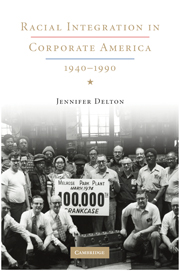Book contents
- Frontmatter
- Contents
- List of Tables
- Introduction
- PART I COLOR-BLIND GROUNDWORK, 1940–1961
- 1 The African American Struggle for Jobs
- 2 Fair Employment Is Good Business
- 3 Racial Liberalism and the Mid-Twentieth-Century Businessman
- 4 Human Relations in Management
- 5 Human Relations at International Harvester and Pitney-Bowes
- PART II COLOR-CONSCIOUS ASCENDANCY, 1961–1990
- Epilogue: From Affirmative Action to Diversity
- Statistical Tables
- Bibliography
- Acknowledgments
- Index
- References
3 - Racial Liberalism and the Mid-Twentieth-Century Businessman
Published online by Cambridge University Press: 05 June 2012
- Frontmatter
- Contents
- List of Tables
- Introduction
- PART I COLOR-BLIND GROUNDWORK, 1940–1961
- 1 The African American Struggle for Jobs
- 2 Fair Employment Is Good Business
- 3 Racial Liberalism and the Mid-Twentieth-Century Businessman
- 4 Human Relations in Management
- 5 Human Relations at International Harvester and Pitney-Bowes
- PART II COLOR-CONSCIOUS ASCENDANCY, 1961–1990
- Epilogue: From Affirmative Action to Diversity
- Statistical Tables
- Bibliography
- Acknowledgments
- Index
- References
Summary
Rare is the citizen who can bring himself to say, “Sure I'm a conservative.”…Any American would sooner drop dead than proclaim himself a reactionary.
Robert Bendiner about the 1950sMany corporate executives were receptive to the arguments of black employment activists after World War II because, like other white elites, they were becoming increasingly concerned about the prevalence of racism, discrimination, and bigotry in American society. They may have been unaware of their own prejudices, but they valued racial fairness and tolerance. Their racial liberalism fit neatly within the “liberal consensus,” a term used to describe the broad bipartisan acceptance of New Deal and cold war policies that dominated American politics from the late 1940s until the election of Ronald Reagan in 1980. Not yet tainted by the excesses of the Great Society, the Vietnam War, and racial extremism, liberalism in the 1950s still connoted open-mindedness, enlightened thinking, and a modern desire to be progressive. Nor was it the provenance of any one political party. There were liberal Democrats and liberal Republicans. Among a certain type of people – educated, informed, public-spirited, influential whites – liberalism was superior to the narrow-minded parochialism associated with conservatives and the lower classes.
In an era of liberal dominance, one's tolerant attitudes about race came to signify, affirm, announce, one's enlightened, liberal character. Among white elites of the 1950s, liberalism was a positive quality. Illiberal, however, meaning bigoted or narrow-minded, was a negative term.
- Type
- Chapter
- Information
- Racial Integration in Corporate America, 1940–1990 , pp. 72 - 98Publisher: Cambridge University PressPrint publication year: 2009



